By Joe Berk
A few years ago I was in a local Turner’s sporting goods store (Turner’s is a big sporting goods chain in the southwestern US) and they had a sale on GSG .22 LR 1911s. I think I paid $229 for it and I’ll admit it: The GSG was an impulse buy. I didn’t need it, but for $229 I thought any kind of 1911 would not be a mistake (I just checked the Turner’s website and they are now $379.99; that’s still not bad). I put the gun in the safe when I bought it and pretty much forgot about it.

I had owned the GSG .22 for several years and I hadn’t fired it. Then, one fine recent morning when I was putting my 9mm 1911 in the range bag, I realized it was dumb not to shoot the little .22. It’s not like it’s ever going to be a collectible, so I thought I might have some fun and enjoy it. The GSG went into the bag, too, for its first firing session.
To my surprise, the GSG is surprisingly accurate and it is fun to shoot. The feel is just like a real 1911 except it’s a bit lighter (as near as I can tell, the exterior dimensions are identical to a full-sized 1911). The trigger is a little on the heavy side (especially after shooting my TJ-modified 9mm Springfield Armory 1911 with its 2 1/2-pound trigger), but the GSG trigger is creep free.
As you can see on the target above (at the top of this blog), the GSG shot slightly to the left. I could see on the slide that the rear sight it was not centered. I fixed that. The rear sight is drift adjustable (it’s held in place with a setscrew), so I moved it a scosh to the right.
The GSG has decent whitish/yellowish (almost aged ivory in color) dot sights front and rear. About that target above: It’s a box of 50 Aguila .22 target loads at 10 yards, with a two-hand hold, firing offhand. I have no excuse for the two outside the 10-ring.
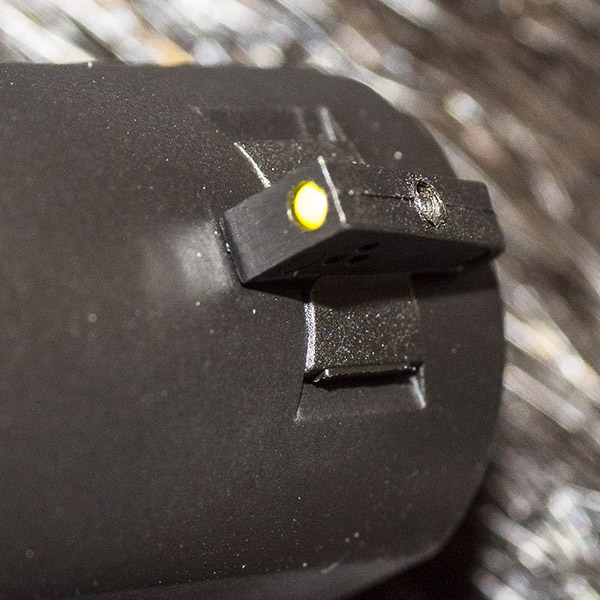
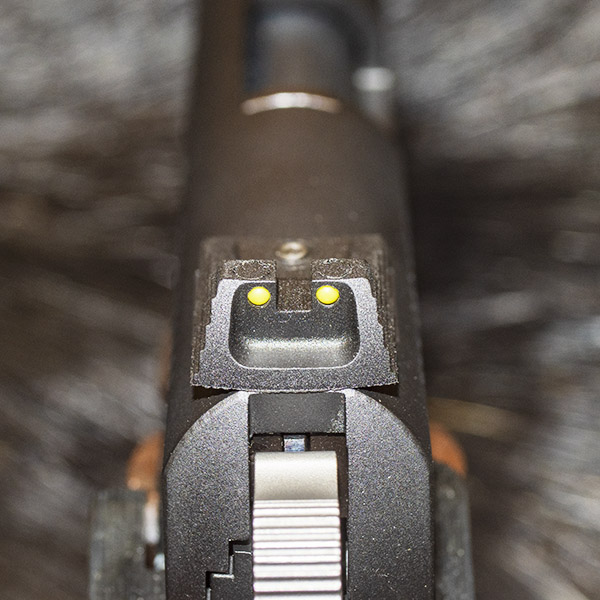
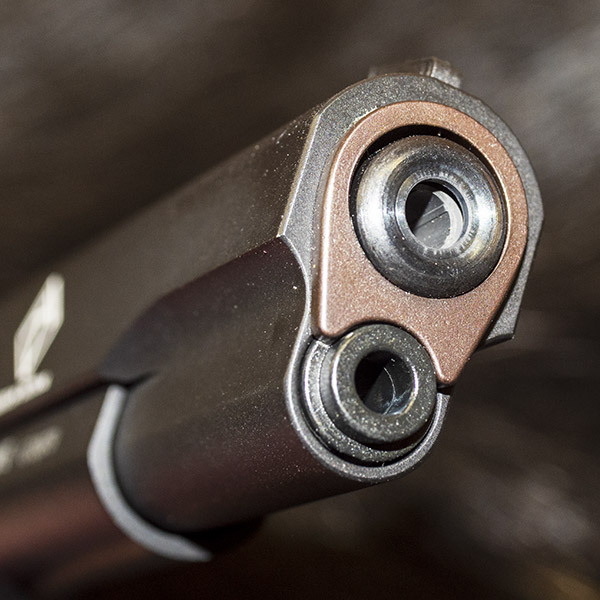
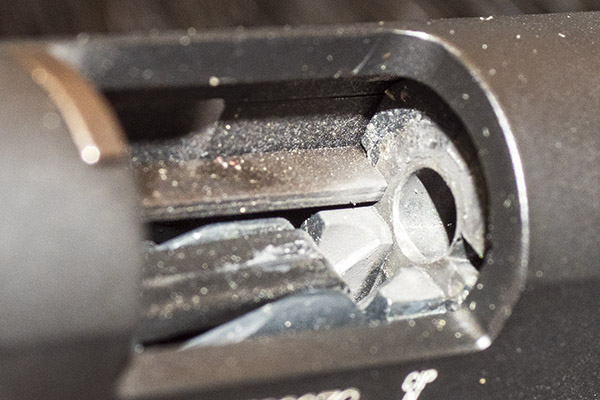
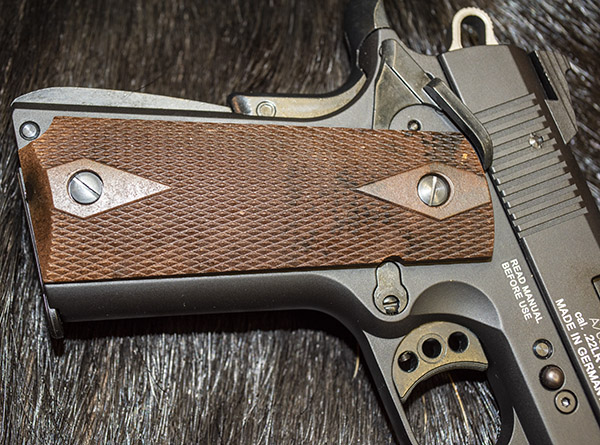
There’s a fair amount of plastic on this gun and I think the finish is some kind of paint, but the gun looks and feels good. The GSG is not a Wilson or a Les Baer 1911, but it doesn’t cost $3500, either.
I don’t know how the GSG takes down or what it looks like inside. I suppose it’s time to read the instructions, and I need to do that so I can clean it. Watch for more on this fun little 1911. You’ll see it right here on our Rimfire Series of blogs. Don’t forget to check out our other gun and reloading articles, which are indexed for your convenience on our Tales of the Gun page.
A quick edit: I took the grips that split on my Springfield Armory 9mm 1911, superglued them back together, and installed them on the GSG .22 (I had to relieve the safety cutout on the right grip to get them to fit). The Springfield grips look good, and they feel better than the injection molded plastic grips than came on the GSG. I had the GSG on the range a couple of days ago and I sent a quick 100 rounds downrange.
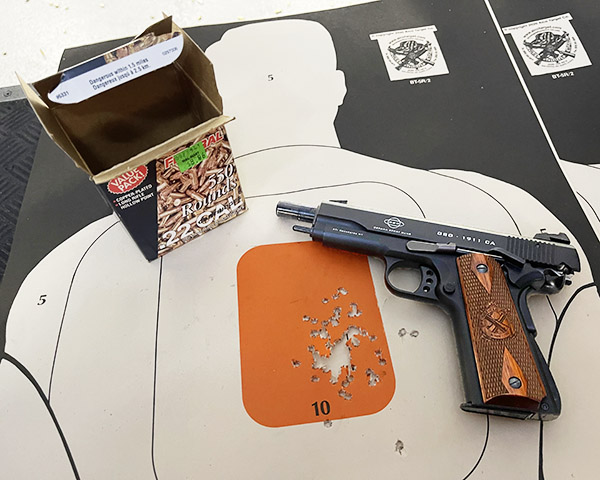
Never miss an ExNotes blog:


I did about exactly the same thing about 10 years ago and also at Turners. Real nice little shooter and has the look and feel of a real 1911 but not the recoil and it just loves to shoot. German made and seems to be of high quality. But a few months back I was again in Turners and saw a Browning 1911-22 which is an 85% sized copy of a 1911 and was intrigued and ended up buying it and its been a real treat. No misfires, stovepipes or failure to ejects right out of the box. Very high quality gun the only drawback being the price as they are not cheap. Look into one of those and if you want to do a review you can borrow mine.
I looked at those when they first came out. The Baby Browning is a beautiful gun. Maybe if you guys click on more popup ads…
22 cal. In 191q frame… I get it, like used Sportster motor in Roadglide. Of course I don’t know much about guns…
That would be cool.
Nice piece,I wish I’d have bought one!
The time to buy it is when you see it. The price only goes up.
I have a similar cheaper made Chiappa 1911-22 that I bought used from a pawn shop. They wanted $195 for it but I talked them down to $150 when I showed that the previous owner had dry fired it a lot and peened the chamber so the shells wouldn’t extract or chamber without help. fixed with a needle file removing the burr. Looks like a full 1911 but is made with a lot of plastic and aluminum. Fake back strap safety, plastic mags and black plastic sights without any dots, non-removable barrel. Shoots fairly well for a plinker. Your GSG looks more like a quality 1911 parts wise.
https://www.chiappafirearms.com/zoom/zoom.php?id=1083&t=1
Interesting. I must have missed that one. I am very pleased with the GSG. It has a lot of plastic, too, but it sure shoots well.